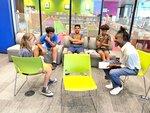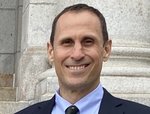

We have a crisis. Mental health issues for young people are skyrocketing, and the need for mental health treatment is not being met.
According to the National Library of Medicine, nearly 20 percent of children and young people ages 3-17 in the United States have a disorder (mental, emotional, developmental, or behavioral), and suicidal behaviors among high school students increased by more than 40 percent in the decade before 2019. Mental health challenges were the leading cause of death and disability in this age group. These trends got worse during the COVID-19 pandemic.
The Surgeon General’s Advisory on Protecting Youth Mental Health has recommendations to improve youth mental health across 11 sectors, including young people and their families, educators and schools, and media and technology companies. Topline recommendations include:
When young people aren't happy—when they are not optimistic, doing positive things, and hopeful about the future—life can get pretty grim for everyone else. And young people today, on average, are unhappier than they have ever been.
A Harvard-led study in 2022 measured overall well-being among adults (18 and older) in the U.S. and found Generation Z (ages 18-25) felt worse in every category: happiness and life satisfaction, mental and physical health, meaning and purpose, character and virtue, close social relationships, financial and material stability.
The senior author of the study, Tyler VanderWeele, a professor of epidemiology at Harvard's School of Public Health and director of the Human Flourishing Program at Harvard’s Institute for Quantitative Social Science, has some theories on why young people are so miserable.
There are a combination of causes. Some of them are financial and the economy. Jobs and the prospects of career advancement are not where they once were. Debt from education and rising housing costs also don't help. Throw in the unhealthy effects of social media, increased family dysfunction, decreased participation in faith communities, political polarization, environmental concerns, and a pandemic. And we have a recipe for existential hopelessness.
But there is hope.
"It’s pretty clear that these domains of well-being are interrelated," says VanderWeele. " If you improve on social relationships, you’re also more likely to subsequently improve on happiness and health and to find meaning. If you have a sense of meaning, find new purpose, you’re likely to become happier and also have better health. So we need to work on each of these aspects: We need to promote relationships and communities. We need to address the financial conditions that young people are facing. We need to help them find systems of meaning."
Now more than ever, we need to help youth develop good health and well-being. There is an art and science to getting happier, and it involves giving to help youth find enjoyment, satisfaction, and meaning in their lives.
A poem by Alberto Ríos captures the essence of this mission:
"When Giving Is All We Have"
One river gives
Its journey to the next.
We give because someone gave to us.
We give because nobody gave to us.
We give because giving has changed us.
We give because giving could have changed us.
We have been better for it,
We have been wounded by it—
Giving has many faces: It is loud and quiet,
Big, though small, diamond in wood-nails.
Its story is old, the plot worn and the pages too,
But we read this book, anyway, over and again:
Giving is, first and every time, hand to hand,
Mine to yours, yours to mine.
You gave me blue and I gave you yellow.
Together we are simple green. You gave me
What you did not have, and I gave you
What I had to give—together, we made
Something greater from the difference.
Two places in my life where I am giving are Big Edition, a digital media company where we are developing a teen well-being program, and the Strong Mind Strong Body Foundation, where we are developing community solutions with youth.
I encourage others to find ways to support youth. What we do in the next few years will shape future generations.
Eric Ortiz lives in the Wedge with his family. When he’s not community building, he’s the head of content and strategy for Big Edition and writes bilingual children’s books with his kids. Their first book, “How the Zookalex Saved the Village,” is available in English and Spanish.
Comments
No comments on this item Please log in to comment by clicking here